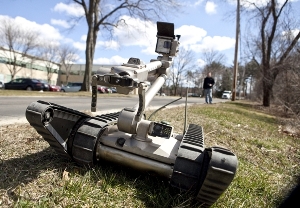While Japan is undergoing a nuclear crisis in the wake of the earthquakes and tsunami, international robotic aid is forthcoming from several nations.
iRobot, a Massachusetts based company, has sent two Warrior and two PackBot robots to measure radiation in contaminated regions, while Germany is planning to send a dozen robots of varying sizes to respond to the nuclear emergency. All these robots have the capacity to withstand radiation. In France, another robotic squad is waiting to receive clearance from the authorities.
 Massachusetts-based iRobot Inc. sent two Packbot and two Warrior robots to Japan to help measure radiation in contaminated areas.
Massachusetts-based iRobot Inc. sent two Packbot and two Warrior robots to Japan to help measure radiation in contaminated areas.
However in Japan which is the super power as far as robotics are concerned the million dollar question would be where are the robots? According to robot experts, the nation had built robots, which could do what humans can do such as dancing, talking and so on, instead of building robots which could go where humans could not.
Hirose Shigeo, a researcher on robotics at the Tokyo Institute of Technology, commented that most of the roboticists in Japan were focused on home use and humanoid robots. Satoshi Tadokoro, an expert in building search and rescue robots in Sendai’s Tohuku University, revealed that the authorities in the Ministry of Trade, Economy and Industry along with the power companies did not authorize building of response and disaster mitigation robots. Tadokoro and Shigeo stated that in 1999, after an accident at a nuclear fuel facility in Tokai, which resulted in the death of two workers, the government, along with the company owning the facility, began developing radiation-resistant robots, but the trade Ministry put an end to the project.
The Nuclear Safety Technology Center had dispatched the Monirobo, which has cameras and hazardous materials monitors, to Fukushima. However it is not yet known whether the robot is being used or not. There was a much greater need for robots that could tolerate radiation after two workers were hospitalized due to exposure to radioactive water. Experts say that if robots had been sent inside the site in the beginning stages of the crisis, key decisions would have been made with the vital data sent back by the robots. Now, no clear information about the extent of damage is being given out in spite of the International Atomic Energy Agency’s demands for information and data.
According to Shigeo, he had developed the Helios IX, a robot which could open doors, climb stairs, withstand high temperatures and radiation. If the robot’s cameras are aimed at the spent fuel pools, then a clear picture would be obtained about the condition of the pools. However, as no one had requested his help or his robot, Shigeo feels his hands were tied down. Tadokoro’s Quince, another reconnaissance robot, could also be roped in for the action.
A spokesperson at The Department of Energy in the US had revealed that the Japanese government had requested for an evaluation of its robotic inventory, as the department has several robots, which could clear up radioactive waste from nuclear fuel processing facilities.
Tadokoro revealed that the government had specifically made a decision on not to invest in building robots for such disasters.